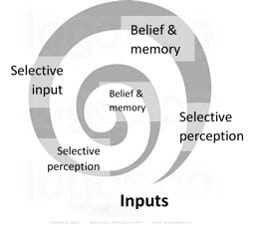Across the bottom of Amazon’s book page it pronounces, “New for you…” Low and behold, there is a list of books based on my past purchasing history.
I follow someone new on Twitter and up pops three more Twitter feeds with the caption “You might also want to follow.”
LinkedIn helpfully suggests, “People you may know.” It provides a list of people based on those I already connected with.
These prompts seem innocuous– helpful, even. If I follow the suggestions, I stay connected to those within my comfortable world. It is a natural inclination. Neuroscience research shows the strong pull to feel connected to our “in-group” – the group that we feel comfortable with because they are, in some way, like us. Perhaps they share our values, history, alma mater, hobbies or interests.
We also know from neuroscience that we form our thoughts, perceptions and beliefs based on the experiences that we have and ones we store. Experiences that influence the brain can come from a variety of sources:
• Books, movies, magazines, social media – anything we hear or read
• Conversations with others – parents, teachers, co-workers, bosses
• Personal experiences – the things we do and live
The more diverse the experiences, the more resources the brain has to draw from; the more confined the experiences, the more limited information from which to form beliefs and memories.
In doing more than 70 leadership interviews, I was struck by the diversity of experiences and influences that these leaders accumulated. Senior leaders in the organization where I spent most of my career typically rotated through many positions within the agency. By the time they reached top leadership potential, they had given themselves a broad background filled with diverse experiences.
All of our influences form memories, values and perceptions that become stored in the brain. The perceptions run our daily lives unconsciously the majority of the time.
In his book, Thinking Fast and Slow, Daniel Kahneman notes biases that the brain tends to fall prey to include the confirmation bias. For example, when given a variety of information to consider about a particular problem, we easily notice the data that is in sync with our belief system. This is the confirmation bias in action. Unless we make an effort to push ourselves out of the easy, comfortable ways of thinking, the process spirals to narrow our perception and vision.
The collective result is depicted here:
 At the beginning of the spiral, we tart with a broad set of inputs that are defined individually. We perceive a subset of those inputs and use the perceptions to create memories and beliefs. Due to the confirmation bias, those memories and beliefs cause us to select a narrower range of future inputs, those inputs that are in alignment with current beliefs. From those more narrow inputs, we select other perceptions that update memories and beliefs. Moreover, the process continues until we have a view of the world that is self-selected to be according to our beliefs.
At the beginning of the spiral, we tart with a broad set of inputs that are defined individually. We perceive a subset of those inputs and use the perceptions to create memories and beliefs. Due to the confirmation bias, those memories and beliefs cause us to select a narrower range of future inputs, those inputs that are in alignment with current beliefs. From those more narrow inputs, we select other perceptions that update memories and beliefs. Moreover, the process continues until we have a view of the world that is self-selected to be according to our beliefs.
This is not a new phenomenon; the brain is designed this way. What is new and growing in influence, is the ability to surround ourselves only with opinions and people that agree with our worldview. Technology is graciously assisting along the way…if we let it.
If I only read books “selected for me” by Amazon, I read books that are similar to what I read in the past. If I only follow people on Twitter who agree with me, those are the only inputs I receive. The same is true for news coverage. Increasingly, I can select the type of “news” that fits my political ideology, thus, ensuring that I am not exposed to nor can I learn from differing points of view.
For leaders, the point is that you choose the inputs in your life. You can choose to see what you’ve always seen. It is convenient, easy and dangerous. And, it is not what a leader is called to do. As a leader, recognize that your brain conspires to see what it has always seen. It likes the certainty and consistency.
Don’t let personalized information that is “just for you” spiral you into narrow beliefs and limited points of view. Leaders are called on to do the energy-intensive work to see broad points of view; feeding their brain with a variety of inputs; considering ideas not in keeping with current beliefs; and seeking input from diverse experiences and diverse points of view. Choose to reverse the spiral; take in increasingly diverse input and recognize the danger of limited beliefs.
“Life is like a 10-speed bicycle and some of us have gears we have never used.” Charles M. Schulz
i. Cacioppo, J.T. & Patrick, B. (2008). Loneliness: human nature and the need for social connection. New York: W.W. Norton and Company.
ii. NeuroLeadership Institute, Memory module, p. 16
iii. Kahneman, Daniel. Thinking, Fast and Slow. Farrar, Straus and Giroux, New York. 2011, pp. 80-81.





0 Comments